Because they are experiencing an explosion of language, many preschool children tend to respond first to the words in a song rather than the rhythm or melody. Once they have heard the whole song and understand the song’s "story," they are most likely to then be able to concentrate on the melodic line. Children are most successful when singing songs that have a limited range, common rhythmic and melodic patterns, simple words, and plenty of repetition. That’s why Kindermusik songs are so catchy!
Joanne Rutowski,  an expert on the child’s voice, describes the stages of vocal, or singing, development:
an expert on the child’s voice, describes the stages of vocal, or singing, development:
The Pre-Singer
Speaks rather than sings; uses little vocal inflection
The Speaking Range Singer
Talk-sings in a limited speaking range, with little vocal inflection
The Limited Range Singer
Sings in a range that is a bit higher than the speaking range but still limited
The Singer
Sings in a wide range; uses much vocal inflection when speaking
So what can you do to foster your child’s singing development?
- Children love singing when they are singing songs they know. Download the tracks from your Home CD onto your iPod at http://play.kindermusik.com and keep your Home CD in the car so that your child can become familiar with the music from this semester.
- Encourage your child to sing in a light head voice.
- Surround your child with a rich listening environment.
- Sing with your child. Love and enjoyment of singing is contagious!
When children are happily singing, they are stimulating all developmental domains: physical, emotional, language, and cognitive. Particularly
significant is the reinforcement singing provides in abilities relating to sequences, patterns, memory, and language.
Compiled by Theresa Case, whose Kindermusik program at Piano Central Studios in Greenville, SC, is proudly among the top 1% of Kindermusik programs worldwide.

